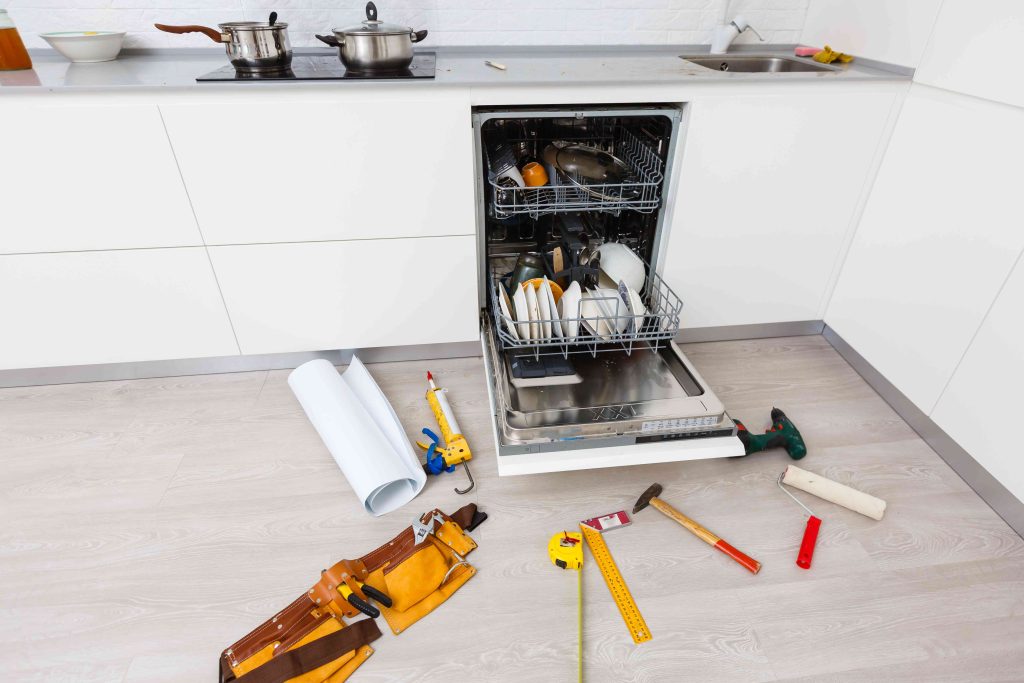Your dishwasher not turning on after you load it with filthy dishes is a major inconvenience. But wait —before you resort to unloading it and handwashing your dishes, try these troubleshooting methods for starting a dishwasher that won’t start.
While some causes may require professional assistance, there are several easy-to-fix issues that may cause a dishwasher not to turn on, such as a child safety lock or the “delay start” setting. Below, we’ve listed 11 reasons your dishwasher won’t start and provided easy troubleshooting steps.
Child Safety Lock Is On
Before you start investigating complex dishwasher issues, start by checking the child safety lock. If accidentally turned on, it will yield many dishwasher functions unavailable.
Want more home reno project tips and inspiration? Sign up for our free daily newsletter for the latest how-tos, reno guides, and more!
Door Isn’t Latching
Many dishwashers will not operate if the door isn’t latching as a safety precaution and to ensure no water leaks from the front of the dishwasher. The door may not be latching because the dishwasher isn’t closed already or because the latch mechanism needs to be serviced or replaced.
Breaker Is Tripped
If your dishwasher has no power at all, head to your electrical panel to check for tripped breakers. Depending on your local building codes, your dishwasher may have a dedicated circuit. If not, there will likely be other lights or outlets without power.
Warning
Breakers serve as safety mechanisms and trip when they sense an issue with the circuit. Only restore the power if you’re sure there is no issue with the circuit. If the circuit trips again after you restore the power, identify the source of the problem before attempting to restore the power.
Water Pan Sensor
The water pan sensor is exactly what it sounds like. It senses water in the pan beneath the dishwasher and alerts the dishwasher. This tells the appliance not to run, as there is a leak. The water pan sensor could be sensing a leak, which should be addressed. However, it could also be that the sensor itself is faulty.
Water Inlet Valve Is Faulty
The water inlet valve is what controls the intake of water into the appliance, as the water pressure on the water supply line is constant. If the water inlet valve is faulty, it will not allow water into the appliance. The dishwasher will not run if it doesn’t sense a water supply is connected.
Appliance Is Unplugged
While many dishwashers are hardwired, some have a common electric cord plugged into an outlet. While it’s unlikely that a dishwasher would just come unplugged at random, it could happen if the appliance was moved or pulled from the wall.
Check to ensure the dishwasher is plugged in and the GFCI outlet hasn’t been tripped. If it has, press the “RESET” button to restore power.
Thermal Fuse Is Blown
Dishwashers are fitted with a thermal fuse, which protects the appliance’s components from extreme heat. If the heat passes a given threshold, the fuse blows and shuts down the appliance. To test the thermal fuse, turn off the breaker and find the fuse (it’s usually on the circuit board beneath the door panel). Visually inspect the fuse.
If you still can’t tell if the thermal fuse is blown, check the continuity using a multimeter or contact an appliance service center for further assistance.
It Needs to Be Reset
Dishwashers have a lot of sensors and controls. Sometimes, they need a simple reset to operate normally. To do so, turn off the circuit breaker for a full minute then turn it back on or check for a specific reset procedure for your make and model.
Sleep Mode Is On
Many dishwashers feature a “sleep” mode or “standby” mode. If either of these features is engaged, the dishwasher won’t turn on as expected. The sleep mode must be deactivated before you can operate the dishwasher.
“Delay Wash” Is Selected
Dishwashers often feature a “Delay Wash” setting, which allows the user to set the dishwasher to turn on at a later point, usually three, six, nine, or more hours later. If your dishwasher is functioning normally but it won’t start when you press “START,” check the delay wash settings to ensure no delay times are selected.
Water Supply Is Off
If you’ve been working on your plumbing or you’ve just installed a new dishwasher, you may have forgotten to turn the dishwasher’s water supply line back on. Failing to do so will prevent any water from reaching the appliance, which will prevent it from turning on, as most models are designed to cancel the operation if they don’t sense a supply of water.
-
How do you reset a dishwasher that won’t turn on?
The simplest way to reset a dishwasher is to turn off the circuit breaker that is supplying the power to the appliance. It’s a good idea to turn off the power for at least 30 seconds to a full minute before restoring it. Other models may include a reset function that consists of holding the “start/reset” button.
-
How do you know if your dishwasher fuse is blown?
To tell if a dishwasher fuse is blown, start with a visual inspection. It’s often obvious when a fuse is blown as there is burnt or melted material. Some types of fuses will even have a visible filament, which will be severed if blown.
If a visual inspection can’t verify the blown fuse, check the two leads for continuity using a multimeter. If it beeps, the fuse is still good.
-
Where is the dishwasher fuse located?
A dishwasher’s thermal fuse is typically located on the control board, which is positioned behind the door panel. Depending on your dishwasher model, you may be able to remove the door panel by removing a few screws.
Read the full article here














